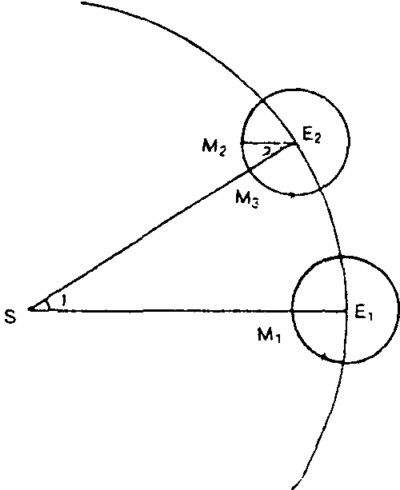Chapter 46 The second movement of the moon
The new moon and the moon are determined by the relative positions of the sun, the moon and the earth, and have nothing to do with the background of the stars.The cycle in which the moon goes around the earth and returns to the same star position is called a sidereal month.As shown in Figure 14, when the earth walks from E1 to E2, the moon also walks from M1 to M2. At this time, M2E2 is equal to M1E1, pointing to the same position in the background of stars, and the time interval from M1 to M2 is a sidereal month.However, the moon still needs to go from M2 to M3 to produce the second moon, so the sidereal month is shorter than the synodic month.And ∠1=∠2, it means that in a synodic month, the moon travels 360° more than the earth, so there is the following formula: 360°/sidereal month×synodic month-360°/tropic year×synodic month=360° That is: the number of degrees the moon walks every day = the number of degrees the moon walks more than the sun per day + the number of degrees the sun walks every day.

Figure 14 Relative relationship between the moon, the sun and the earth
The position of the moon on any day can be deduced by using the above formula.During the Spring and Autumn Period and the Warring States Period, people have been able to skillfully use this formula to predict the position of the moon.Of course, in the specific calculation, the 360° in the formula should be the traditional Chinese 3601/4 degree.
Li Fan and Su Tong of the Western Han Dynasty compared the records of previous generations of history books and found that the moon's movement was not only fast or slow, but also that the fastest position itself was constantly moving forward.The fastest point, in modern astronomical terms, is the perihelion.If the perihelion is fixed, the time interval for the moon to pass the perihelion twice, that is, the perihelion month, is equal to a sidereal month.When the perihelion moves, the moon takes longer to get back to perigee than the sidereal moon, in other words, the perihelion month is longer than the sidereal month.Since the anomalous month actually shows the cycle of the moon's movement, the data of the anomalous month should be used when correcting the average speed of the moon.The earliest known monthly value of anomalous point comes from the Qianxiang calendar of the Eastern Han Dynasty, which is 27.554756 days, with an error of 0.000206 days, or more than 17 seconds.In the Qianxiang calendar, Liu Hong added the correction of the average speed of the moon for the first time.

Figure 14 Relative relationship between the moon, the sun and the earth
